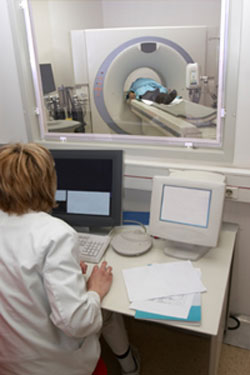
Symptoms
The first symptoms of colon cancer are usually vague, like bleeding, weight loss, and fatigue (tiredness). Local (bowel) symptoms are rare until the tumor has grown to a large size. Generally, the nearer the tumor is to the anus, the more bowel symptoms there will be.
Symptoms and signs are divided into local, constitutional and metastatic.
Local symptoms
* Change in bowel habits
o Change in frequency (constipation and/or diarrhea),
o Feeling of incomplete defecation (tenesmus) and reduction in diameter of stool, both characteristic of rectal cancer,
o Change in the appearance of stools:
+ Bloody stools or rectal bleeding
+ Stools with mucus
+ Black, tar-like stool (melena), more likely related to upper gastrointestinal e।g। stomach or duodenal disease
* Bowel obstruction causing bowel pain, bloating and vomiting of stool-like material।
* A tumor in the abdomen, felt by patients or their doctors.
* Symptoms related to invasion by the cancer of the bladder causing hematuria (blood in the urine) or pneumaturia (air in the urine), or invasion of the vagina causing maloderous vaginal discharge. These are late events, indicative of a large tumor.
Constitutional (systemic) symptoms
* Unexplained weight loss is a worrying symptom caused by lack of appetite and systemic effects of a malignant growth. However, weight loss is not as much a feature of colorectal cancer as it is of other cancers (e.g. oesophageal carcinoma). * Anemia, causing dizziness, fatigue and palpitations. Clinically, there will be pallor and blood tests will confirm the low hemoglobin level.
Metastatic symptoms
* Liver metastases, causing:
o Jaundice
o Pain in the abdomen, more often the upper part of epigastrium or right side of the abdomen
o liver enlargement, usually felt by a doctor
* Blood clots in the veins and arteries, a paraneoplastic syndrome related to hypercoagulability of the blood (the blood is "thickened")
Risk factors
The lifetime risk of developing colon cancer in the United States is about 7%. Certain factors increase a person's risk of developing the disease.[2] These include:
* Age. The risk of developing colorectal cancer increases with age. Most cases occur in the 60s and 70s, while cases before age 50 are uncommon unless a family history of early colon cancer is present.
* Polyps of the colon, particularly adenomatous polyps, are a risk factor for colon cancer. The removal of colon polyps at the time of colonoscopy reduces the subsequent risk of colon cancer.
* History of cancer. Individuals who have previously been diagnosed and treated for colon cancer are at risk for developing colon cancer in the future. Women who have had cancer of the ovary, uterus, or breast are at higher risk of developing colorectal cancer.
* Heredity:
o Family history of colon cancer, especially in a close relative before the age of 55 or multiple relatives
o Familial adenomatous polyposis (FAP) carries a near 100% risk of developing colorectal cancer by the age of 40 if untreated
o Hereditary nonpolyposis colorectal cancer (HNPCC) or Lynch syndrome
* Smoking. Smokers are more likely to die of colorectal cancer than non-smokers. An American Cancer Society study found that "Women who smoked were more than 40% more likely to die from colorectal cancer than women who never had smoked. Male smokers had more than a 30% increase in risk of dying from the disease compared to men who never had smoked."[3]
* Diet. Studies show that a diet high in red meat[4] and low in fresh fruit, vegetables, poultry and fish increases the risk of colorectal cancer. In June 2005, a study by the European Prospective Investigation into Cancer and Nutrition suggested that diets high in red and processed meat, as well as those low in fiber, are associated with an increased risk of colorectal cancer. Individuals who frequently eat fish showed a decreased risk.[1] However, other studies have cast doubt on the claim that diets high in fiber decrease the risk of colorectal cancer; rather, low-fiber diet was associated with other risk factors, leading to confounding.[5] The nature of the relationship between dietary fiber and risk of colorectal cancer remains controversial.
* Physical inactivity. People who are physically active are at lower risk of developing colorectal cancer.
* Virus. Exposure to some viruses (such as particular strains of human papilloma virus) may be associated with colorectal cancer.
* Primary sclerosing cholangitis offers a risk independent to ulcerative colitis * Low levels of selenium.
* Inflammatory Bowel Disease. [6] [7] About one percent of colorectal cancer patients have a history of chronic ulcerative colitis. The risk of developing colorectal cancer varies inversely with the age of onset of the colitis and directly with the extent of colonic involvement and the duration of active disease. Patients with colorectal Crohn's disease have a more than average risk of colorectal cancer, but less than that of patients with ulcerative colitis. [8]
* Environmental Factors. [6] Industrialized countries are at a relatively increased risk compared to less developed countries or countries that traditionally had high-fiber/low-fat diets. Studies of migrant populations have revealed a role for environmental factors, particularly dietary, in the etiology of colorectal cancers.
* Exogenous Hormones. The differences in the time trends in colorectal cancer in males and females could be explained by cohort effects in exposure to some sex-specific risk factor; one possibility that has been suggested is exposure to estrogens [9]. There is, however, little evidence of an influence of endogenous hormones on the risk of colorectal cancer. In contrast,there is evidence that exogenous estrogens such as hormone replacement therapy (HRT), tamoxifen, or oral contraceptives might be associated with colorectal tumors. [10]
* Alcohol. Drinking, especially heavily, may be a risk factor.







